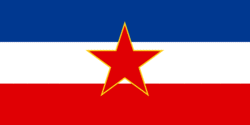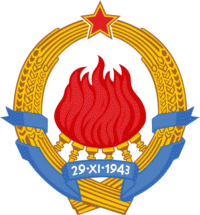| The Socialist and Federal Republic of Yugoslavia Socijalisticka Federativna Jugoslavija
Facts and Figures
Bordered By Italy, Austria, Hungary, Romania, Bulgaria, Greece, Albania
Area 98,766 sq mi
Greatest Distance E-W 475 mi
Greatest Distance N-S 415 mi
Coastline 490 mi
Highest Point Mount Triglav; 9,393 ft
Lowest Point sea level
Population (at time of dissolution)
23,724,919
Largest Cities Belgrade, Zagreb,
Skopje, Sarajevo, Ljubljana, Split, Nova Sad, Rijeka
Capital Belgrade
Form of Government socialist republic
National Anthem Hej Sloveni
("Hey Slavs")
Flag horizontal stripes of blue, white,
and red, with a red star in the middle
Coat of Arms there is one torch for each
of the nation's six republics; the date marks the start
of Communist rule


Timeline of Important Events
December 1, 1918 The Kingdom of the
Serbes, Croats, and Slovenes was formed, uniting for the
first time the region that became Yugoslavia.
1921 A new constitution, providing for a
constitutional monarchy, was adopted.
1929 King Alexander I changed the name
of the country to Yugoslavia and began to rule as a
dictator.
1934 Croatian terrorists assassinated
Alexander I.
1941 The Yugoslavian army overthrew
the pro-German government. Germany and other
Axis powers invaded Yugoslavia. Josip Broz Tito organized
the Partisans, a resistance army.
1944 Aided by Soviet troops, the
Partisans freed Belgrade from German occupation.
November 29, 1945 The country's name was
changed to the Federal People's Republic of Yugoslavia.
1946 A new constitution established six
constituent republics: Bosnia and
Herzegovina, Croatia, Macedonia, Montenegro, Serbia, and Slovenia.
1947 Italy
ceded most of Venezia Giulia to Yugoslavia.
1948 The Soviet Union broke off
relations with Yugoslavia.
1953 Marshal Tito was chosen as
President of Yugoslavia.
1963 The country was renamed the
Socialist Federal Republic of Yugoslavia and Tito was
named President for Life.
May 4, 1980 President Josip Broz Tito
died.
1984 Sarajevo hosted the Winter
Olympics.
1991 Croatia and Slovenia declared
their independence from Yugoslavia. Slovenia was invaded
by Yugoslav troops, tanks, and aircraft, starting the
Ten-Day War.
1992 The international community
recognized the independence of Slovenia and Croatia.
Bosnia and Herzegovina declared its independence from
Yugoslavia.
See Also
Italy
Austria
Hungary
Romania
Bulgaria
Greece
Albania
Belgrade
Germany
Bosnia and Herzegovina
Montenegro
Serbia
Italy
Questions
or comments about this page?
|
